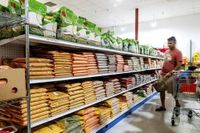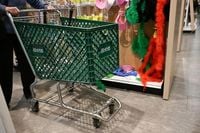Shoppers across the United States continued to open their wallets in July 2025, pushing retail sales up by 0.5% compared to the previous month, according to the latest figures released by the U.S. Commerce Department. Despite ongoing concerns about tariffs, inflation, and a cooling job market, Americans appeared determined to maintain their spending habits—at least for now.
The Commerce Department’s report, published on August 15, 2025, pegged total U.S. retail sales in July at $726.3 billion, a figure that not only matched economists’ expectations but also represented a 3.9% increase year-over-year from July 2024. This growth came on the heels of an upward revision for June’s retail sales, now reported as a 0.9% increase, up from the previously announced 0.6% rise.
“Consumers have a little more spring in their step,” Christopher S. Rupkey, chief economist at FWDBonds LLC, told The Blueprint. “Whether this is simply whistling in the dark, time will tell, but the tariff headline chaos did not keep consumers at home in July with the one caveat that they reduced their dining out spending.”
Auto dealerships saw a particularly strong month, with sales climbing 1.6%. That uptick helped offset drops in other areas, such as electronics, which declined by 0.6%, and building materials. Clothing stores enjoyed a 0.7% rise, while home furnishings and furniture businesses posted a 1.4% increase. Online retailers also fared well, with sales up 0.8% month-over-month, a trend attributed partly to July’s spate of summer shopping events.
Amazon’s annual Prime Day, which ran for a record four days from July 8 to July 11, played a significant role in boosting online sales. According to Digital Commerce 360, U.S. consumers spent $24.1 billion online during the Prime Day period, not including Amazon’s own sales. The National Retail Federation (NRF) reported that July 2025 online retail sales reached $127.05 billion, marking an 8% jump from July 2024 and a 0.8% increase over June 2025. Online sales now account for 17.49% of all retail sales, up from 16.80% a year ago, and a whopping 23.70% of core retail sales (excluding autos and gasoline).
“Month-over-month gains were sizeable against a weaker-than-normal June,” NRF president and CEO Matthew Shay said, noting that consumers are “continuing to pull purchases forward ahead of tariffs.” He also observed that, even with weaker job growth, “consumers still have the ability to spend on household priorities as wages are growing above the rate of inflation.”
Indeed, promotions weren’t limited to Amazon. Walmart and Target, among others, launched competing online sales, further fueling the July surge. Online grocery sales reached $10 billion, up $2.1 billion from the previous July, as more Americans opted to stock up from home.
But not all sectors shared in the bounty. Electronics and appliance stores saw a 0.51% drop in sales compared to June, despite a 2.11% year-over-year increase. Restaurants, a traditional bellwether for discretionary spending, experienced a 0.4% decline, suggesting that some shoppers are opting to dine at home to save money. The only major category to see a year-over-year decline was building and garden supply stores, which dropped 4.11%.
July’s retail activity likely got a lift from both promotional events and a partial recovery in consumer sentiment. A University of Michigan survey showed that consumer confidence, which had bottomed out in the spring following a stock market dive and the announcement of sweeping tariffs by President Donald Trump, improved somewhat over the summer. However, the August reading dipped to 58.6 points from 61.7 in July, with year-ahead inflation expectations rising to 4.9% from 4.5%.
“Consumers are no longer bracing for the worst-case scenario for the economy feared in April when reciprocal tariffs were announced and then paused,” survey director Joanne Hsu explained. “However, consumers continue to expect both inflation and unemployment to deteriorate in the future.”
Tariffs remain a persistent worry for the retail industry. While President Trump has suspended some of the most severe measures and announced preliminary trade deals with key partners like Japan and the European Union, the overall tariff rate remains historically high. Trump told reporters he would impose new tariffs on semiconductors and steel in the coming weeks, keeping businesses and consumers guessing about future price hikes.
For now, many retailers are absorbing the increased costs from tariffs rather than passing them directly to shoppers. Neil Saunders of GlobalData observed, “Many retailers are so far accepting lower profit margins and absorbing some of the tariffs with the intention of eventually offsetting it through cost reductions elsewhere.” Still, some companies have begun selectively raising prices. Walmart, for instance, bumped up the price of imported bananas from 50 cents to 54 cents per pound in June. Warby Parker, meanwhile, has increased prices on select premium lens types but kept its $95 option steady to maintain accessibility.
Despite these adjustments, signs of strain are emerging. U.S. employers added only 73,000 jobs in July, well below the 115,000 expected, according to the Labor Department. This slowdown in hiring comes as businesses grapple with Trump’s trade policies and the resulting uncertainty. Inflation data showed consumer prices up 2.7% year-over-year in July, with core prices (excluding food and energy) rising 3.1%. Wholesale inflation, a leading indicator of future consumer price increases, surged 0.9% from June—the largest jump in more than three years—while wholesale prices were up 3.3% over the year.
“This report will ease some of the worries about the health of consumers’ spending following the tariff shock,” Oliver Allen, senior U.S. economist at Pantheon Macroeconomics, wrote in a note. “That said, growth in consumption still looks relatively weak, and the softening labor market and further likely pass-through of tariffs suggest a sharp reacceleration is unlikely.”
Retailers and analysts alike are watching closely as major chains like Walmart and Target prepare to release their second-quarter earnings. These reports will offer more clues about how much of the tariff burden is being absorbed by businesses versus passed on to consumers, and how shoppers are adjusting their habits as the all-important fall and winter holiday seasons approach.
With prices rising and job growth slowing, the sustainability of America’s robust consumer spending remains an open question. For now, however, shoppers are keeping the cash registers ringing—even as storm clouds gather on the economic horizon.


